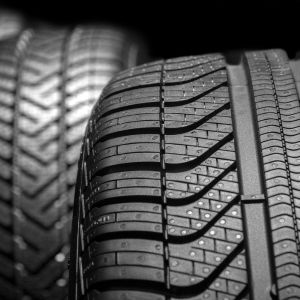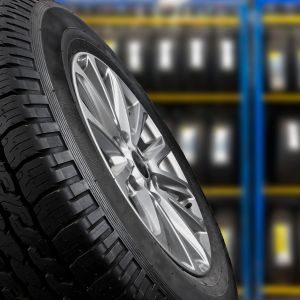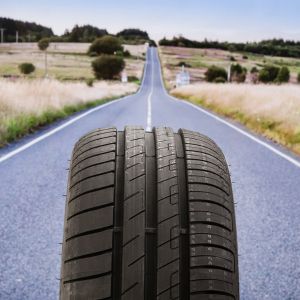Run flat tyres are pneumatic car tyres that don’t deflate after they’re punctured, allowing the car to be driven for a short distance at slower speeds. These tyres contain an additional lining inside the tyre that will self-seal if a nail or screw causes a minor hole. By preventing air loss from the beginning, a tyre is either permanently self-repairing or loses air extremely gradually.
Run flat tyres are built to continue rolling even after being punctured or losing air pressure. Retrofitted tyre sealants are also available, and they function similarly to self-sealing tyres. The compound is subsequently dispersed by the rotational force onto the tire’s inner surface, where it serves as a self-sealing lining. They have reinforced sidewalls that enable the vehicle to go just a short distance and at a slower speed, usually around 50 miles (80 kilometres) at a top speed of 50 mph (80 kilometres per hour).
What are the benefits of run flat tyres?

These tires contain an extra lining within the tire that self-seals in the event of a small hole due to a nail or screw. In this way, the loss of air is prevented from the outset such that the tire is either permanently self-repairing or at least loses air very slowly.
- Run flat tyres reduce the danger of an accident brought on by unexpected tyre failure by enabling a vehicle to continue travelling even after a puncture. The car can be driven to a secure area for maintenance or replacement while the driver maintains control of the wheel.
- Run flat tyres, which are especially helpful in remote or hazardous places, enable a vehicle to continue going for a constrained distance and at a slower speed following a puncture.
- Run flat tyres allow the car to be driven to a repair facility, saving the time necessary to change a tyre on the side of the road.
- Run flat tyres can save money over time by removing the requirement for a spare tyre and all of its associated expenses, including storage, upkeep, and replacement.
- Additionally, run flat tyres can be employed to enhance vehicle design. They increase the vehicle’s load-carrying capacity while allowing for more aerodynamic and compact designs.
When to use the run-flat tyres?

Run-flat tyres are typically used in situations where it is critical to be able to continue driving after a car puncture or loss of air pressure. Here are a couple of examples:
- Run flat tyres can be useful in urban environments where a flat tyre would cause delays or traffic problems.
- Run flat tyres are commonly used on emergency vehicles such as police cars and ambulances because they allow the vehicle to continue moving even when the tyres are flat.
- Cars without spare tyres can use run flat tyres, which eliminates the need for a spare tyre and the inconvenience of changing a tyre on the side of the road.
Comparison of the normal tyre and flat run tyre

Normal tyres and run flat tyres have their own advantages and disadvantages. Here is a comparison of the two types of tyres:
Normal Tyres:
- These tyres cost less than run-flat ones.
- They are ideal for a wider variety of automobiles because they come in a greater range of sizes and models.
- They offer a smoother ride than run-flat tyres because of their softer sidewalls.
- They are simpler to replace or repair if they are ruptured.
Run-flat Tyres:
- These tyres allow a vehicle to continue moving for a limited distance and at a slower speed after a puncture, which is useful in remote or dangerous areas.
- They do away with the need for a spare tyre, saving space and weight in the vehicle.
- They can be used to improve vehicle design by enabling more compact and aerodynamic designs.
- They increase the vehicle’s load-carrying capacity.
- They can save money because they eliminate the need for a spare tyre and the associated costs of storage, maintenance, and replacement.
Technologies associated with run flat tyre
Self- supporting: Self-supporting run-flat tires are now common on light trucks and passenger cars, allowing the vehicle to travel 50 miles (80 kilometers) at approximately 50 miles per hour (80 km/h).
Self sealing: These tires have an extra lining within the tire that self-seals if a small hole is caused by a nail or screw. In this manner, air loss is avoided from the start, resulting in a tire that is either permanently self-repairing or loses air very slowly.
Auxiliary Supported: In this system, an additional support ring or insert is attached to the wheel and can support the vehicle’s weight in the event of a pressure loss. The run-flat insert is unrivaled in its ability to transport heavy vehicle loads over long distances at high speeds.
Which tyre is better, run-flat or normal?
Various criteria, as well as individual driving needs and preferences, determine whether run-flat or regular tyres are preferable.
Run-flat tyres are made to be driven, usually for a short distance and speed, even after losing air pressure. They have sidewalls that are strengthened, which enables the tyre to keep its shape and offer a certain amount of stability and control. In the event of a puncture, this can be helpful as it enables you to keep moving to a secure area for a tyre change rather than having to repair a flat tyre on the side of the road.
Normal tyres, on the other hand, need to be replaced or repaired right away if they start to lose air pressure. They often last longer than run-flat tyres, are more comfortable, and offer greater grip and handling. They frequently cost less as well.
In the end, your decision between run-flat and regular tyres will be influenced by your driving habits, financial situation, car’s make and model, and personal preferences. Run-flat tyres could be a smart choice if convenience and security are your top priorities. Normal tyres can be a better option if performance and value are your top priorities.
It’s crucial to remember that run-flat tyres are more expensive to replace than regular tyres because they are often only offered as original equipment on a certain number of vehicle types. Run-flat tyres are not appropriate for all driving and weather circumstances, so it’s vital to speak with a tyre expert or the manufacturer of your car to find the best solution for your requirements.
Frequently Asked Questions
Q1. What are the advantages of run-flat tyres?
Ans: The advantages of run-flat tyres include:
- Increased Safety: Run-flat tyres increase safety because they let drivers keep going even after a puncture, lowering the danger of accidents brought by by abrupt deflation.
- Less Hassle: Since run-flat tyres don’t need a spare, changing a wheel is less difficult.
- Run-flat tyres have reinforced sidewalls that enhance handling and stability even after a puncture.
- Better Handling.
- Less Fuel Consumption: Run-flat tyres minimise fuel consumption since they are lower in weight and have less rolling resistance.
Q2. Is it worth getting run-flat tyres?
Ans: It depends on your needs. Run-flat tires are more resistant to punctures and blowouts, but they are more expensive and may be less comfortable than standard tires. They also live for a shorter period of time.
Q3. Which tyre is better, run-flat or normal?
Ans: Normal and run-flat tyres each have advantages and disadvantages. Run-flat tyres provide the added convenience of being able to drive for a limited distance on a flat tyre, but they are frequently more expensive than traditional tyres, and not all vehicles can use them.
Q4: Do run-flat tyres last longer?
Ans: It is not always true that run-flat tyres last longer, as tyre life is affected by a number of factors, including usage, driving conditions, and maintenance.

